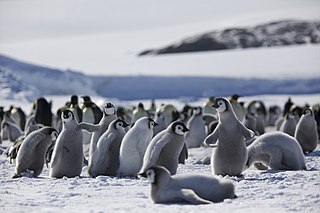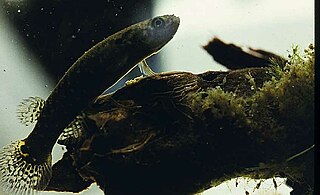
Mutualism describes the ecological interaction between two or more species where each species has a net benefit. Mutualism is a common type of ecological interaction. Prominent examples include most vascular plants engaged in mutualistic interactions with mycorrhizae, flowering plants being pollinated by animals, vascular plants being dispersed by animals, and corals with zooxanthellae, among many others. Mutualism can be contrasted with interspecific competition, in which each species experiences reduced fitness, and exploitation, or parasitism, in which one species benefits at the "expense" of the other.

Pica is the genus of seven species of birds in the family Corvidae in both the New World and the Old.

Behavioral ecology, also spelled behavioural ecology, is the study of the evolutionary basis for animal behavior due to ecological pressures. Behavioral ecology emerged from ethology after Niko Tinbergen outlined four questions to address when studying animal behaviors: What are the proximate causes, ontogeny, survival value, and phylogeny of a behavior?

The handicap principle is a hypothesis proposed by Amotz Zahavi to explain how evolution may lead to "honest" or reliable signalling between animals which have an obvious motivation to bluff or deceive each other. It suggests that costly signals must be reliable signals, costing the signaller something that could not be afforded by an individual with less of a particular trait. For example, in sexual selection, the theory suggests that animals of greater biological fitness signal this status through handicapping behaviour, or morphology that effectively lowers this quality. The central idea is that sexually selected traits function like conspicuous consumption, signalling the ability to afford to squander a resource. Receivers then know that the signal indicates quality, because inferior quality signallers are unable to produce such wastefully extravagant signals.

In ethology, territory is the sociographical area that an animal of a particular species consistently defends against conspecifics. Animals that defend territories in this way are referred to as territorial.
Evolutionary game theory (EGT) is the application of game theory to evolving populations in biology. It defines a framework of contests, strategies, and analytics into which Darwinian competition can be modelled. It originated in 1973 with John Maynard Smith and George R. Price's formalisation of contests, analysed as strategies, and the mathematical criteria that can be used to predict the results of competing strategies.
Dominance hierarchy is a type of social hierarchy that arises when members of a social group interact, to create a ranking system. In social living groups, members are likely to compete for access to limited resources and mating opportunities. Rather than fighting each time they meet, relative rank is established between members of the same sex. Based on repetitive interactions a social order is created that is subject to change each time a dominant animal is challenged by a subordinate one.
The marginal value theorem (MVT) is an optimality model that usually describes the behavior of an optimally foraging individual in a system where resources are located in discrete patches separated by areas with no resources. Due to the resource-free space, animals must spend time traveling between patches. The MVT can also be applied to other situations in which organisms face diminishing returns.

Hyla is a genus of frogs in the tree frog family Hylidae. As traditionally defined, it was a wastebasket genus with more than 300 species found in Europe, Asia, Africa, and across the Americas. After a major revision of the family most of these have been moved to other genera so that Hyla now only contains 17 extant (living) species from Europe, northern Africa and Asia. The earliest known fossil member of this genus is †Hyla swanstoni from the Eocene of Saskatchewan, Canada, but its designation to Hyla happened before the major revision, meaning that its position needs confirmation.

Intraspecific competition is an interaction in population ecology, whereby members of the same species compete for limited resources. This leads to a reduction in fitness for both individuals, but the more fit individual survives and is able to reproduce. By contrast, interspecific competition occurs when members of different species compete for a shared resource. Members of the same species have rather similar requirements for resources, whereas different species have a smaller contested resource overlap, resulting in intraspecific competition generally being a stronger force than interspecific competition.

Dominance in ethology is an "individual's preferential access to resources over another".
Monogamous pairing in animals refers to the natural history of mating systems in which species pair bond to raise offspring. This is associated, usually implicitly, with sexual monogamy.
In ecology, an ideal free distribution (IFD) is a theoretical way in which a population's individuals distribute themselves among several patches of resources within their environment, in order to minimize resource competition and maximize fitness. The theory states that the number of individual animals that will aggregate in various patches is proportional to the amount of resources available in each. For example, if patch A contains twice as many resources as patch B, there will be twice as many individuals foraging in patch A as in patch B.

Agonism is a broad term which encompasses many behaviours that result from, or are triggered by biological conflict between competing organisms. Approximately 23 shark species are capable of producing such displays when threatened by intraspecific or interspecific competitors, as an evolutionary strategy to avoid unnecessary combat. The behavioural, postural, social and kinetic elements which comprise this complex, ritualized display can be easily distinguished from normal, or non-display behaviour, considered typical of that species' life history. The display itself confers pertinent information to the foe regarding the displayer's physical fitness, body size, inborn biological weaponry, confidence and determination to fight. This behaviour is advantageous because it is much less biologically taxing for an individual to display its intention to fight than the injuries it would sustain during conflict, which is why agonistic displays have been reinforced through evolutionary time, as an adaptation to personal fitness. Agonistic displays are essential to the social dynamics of many biological taxa, extending far beyond sharks.
Polygyny is a mating system in which one male lives and mates with multiple females but each female only mates with a single male. Systems where several females mate with several males are defined either as promiscuity or polygynandry. Lek mating is frequently regarded as a form of polygyny, because one male mates with many females, but lek-based mating systems differ in that the male has no attachment to the females with whom he mates, and that mating females lack attachment to one another.

Consumer demand tests for animals are studies designed to measure the relative strength of an animal's motivation to obtain resources such as different food items. Such demand tests quantify the strength of motivation animals have for resources whilst avoiding anthropomorphism and anthropocentrism.
In ecology, contest competition refers to a situation where available resources, such as food and mates, are utilized only by one or a few individuals, thus preventing development or reproduction of other individuals. It refers to a hypothetical situation in which several individuals stage a contest for which one eventually emerges victorious. Contest competition is the opposite of scramble competition, a situation in which available resources are shared equally among individuals.
Evolutionary biologists have developed various theoretical models to explain the evolution of food-sharing behavior—"the unresisted transfer of food from one food-motivated individual to another"—among humans and other animals.

The winner and loser effect is an aggression phenomenon in which the winner effect is the increased probability that an animal will win future aggressive interactions after experiencing previous wins, while the loser effect is the increased probability that an animal will lose future aggressive interactions after experiencing previous losses. Overall these effects can either increase or decrease an animals aggressive behaviour, depending on what effect affects the species of concern. Animals such as Agkistrodon contortrix, Rivulus marmoratus, and Sula nebouxii show either both or one of these effects.
Social rank theory provides an evolutionary paradigm that locates affiliative and ranking structures at the core of many psychological disorders. In this context, displays of submission signals to dominant individuals that subordinate group members are not a threat to their rank within the social hierarchy. This helps to achieve social cohesion. According to social rank theory, anxiety and depression are natural experiences that are common to all mammalian species. It is the pathological exaggeration of anxiety and depression that contributes to psychological disorders.












